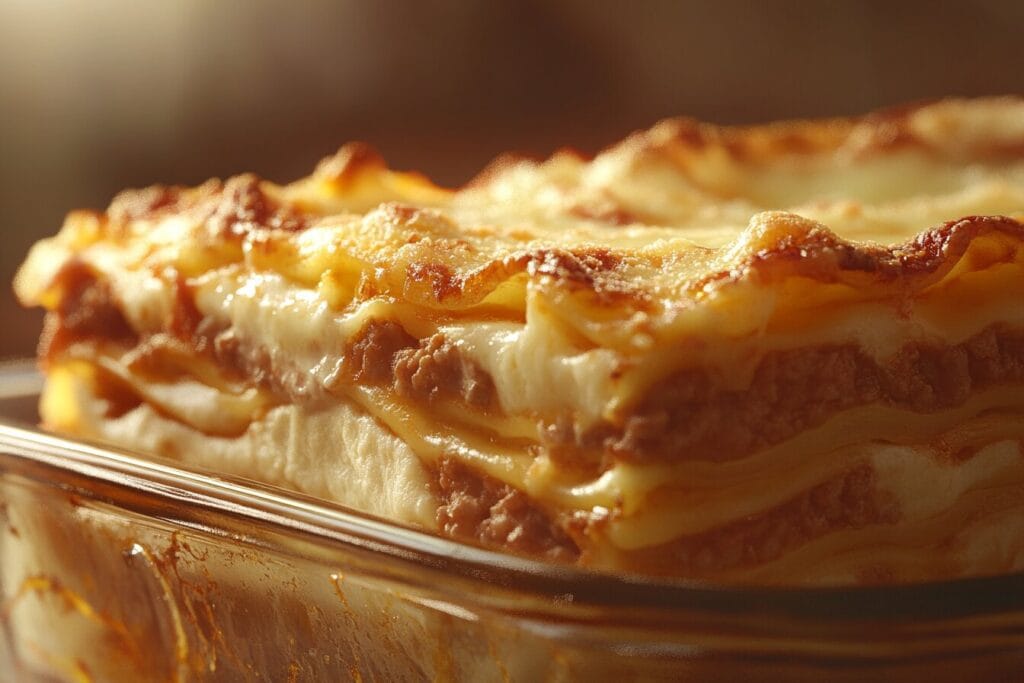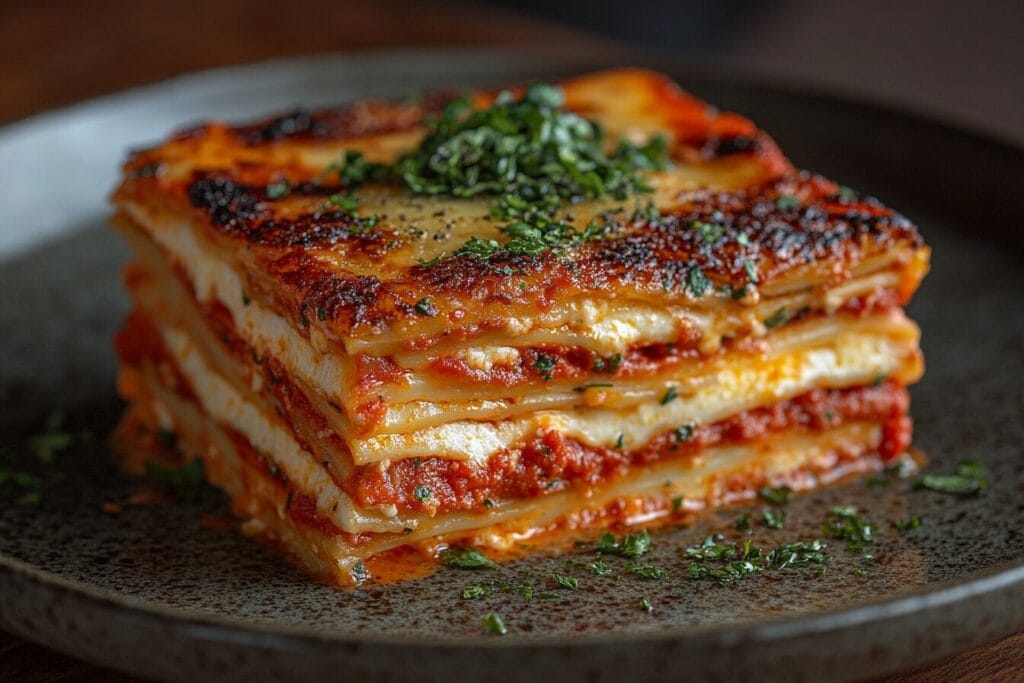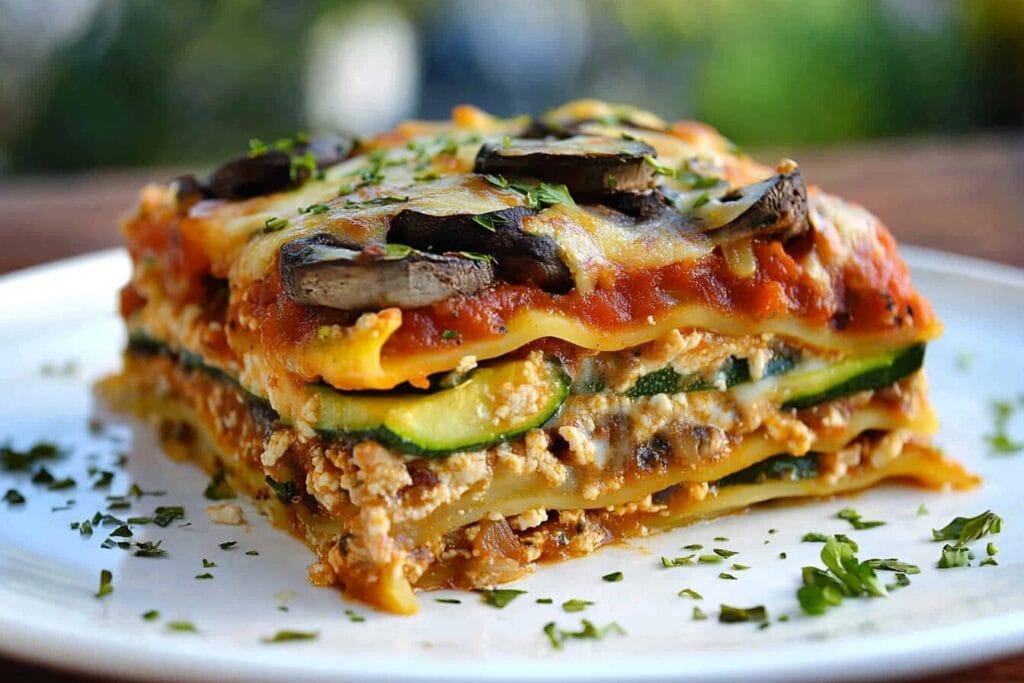Introduction
Lasagna is more than just a dish; it’s a symphony of flavors, textures, and layers that come together to create a timeless classic loved worldwide. From its Italian roots to its global variations, lasagna has evolved into a meal that is both comforting and celebratory. At the heart of a great lasagna lies the question: how many layers should it have?
This query has sparked debates among home cooks, culinary experts, and food enthusiasts. Some argue for simplicity, while others believe in stacking layers to create a masterpiece worthy of admiration. But what’s the science behind the perfect lasagna layering? How do different factors such as pan size, ingredients, and tradition shape the answer? This article dives into the anatomy of lasagna, explores the factors influencing its layers, and helps you find the perfect recipe for your next culinary adventure.

The Anatomy of a Lasagna
Lasagna, at its core, is a layered casserole dish that brings together a harmonious blend of ingredients. While the variations are endless, the fundamental components of lasagna remain consistent across most recipes. Understanding these elements is key to mastering the art of layering.
Essential Components of a Classic Lasagna
- Lasagna Pasta Sheets
The foundation of any lasagna lies in its pasta sheets. Traditionally made from durum wheat flour, lasagna noodles are designed to separate the layers while absorbing moisture and flavor from the surrounding ingredients. Fresh pasta sheets add a delicate texture, while dried sheets offer convenience and structure. - Sauce
- Tomato-Based Sauce: Rich in flavor, the tomato sauce is often simmered with herbs, garlic, and sometimes meat. It provides acidity and moisture, balancing the dish.
- Bechamel (White Sauce): In traditional Italian lasagna, a creamy béchamel sauce is used instead of or alongside tomato sauce to add richness and smoothness to the layers.
- Cheese
Cheese is the crowning glory of a lasagna, offering creaminess and a golden, bubbly crust when baked.- Ricotta or Cottage Cheese: Used for creamy, soft layers.
- Mozzarella: Melts beautifully and creates that signature cheesy stretch.
- Parmesan: Adds sharpness and a nutty flavor.
- Fillings
Fillings define the character of your lasagna. Popular options include:- Meat: Ground beef, sausage, or pork provide a hearty and savory element.
- Vegetables: Spinach, zucchini, mushrooms, and eggplant are popular vegetarian choices.
- Herbs and Spices: Basil, oregano, and parsley enhance the flavor.
The Role of Layers in Lasagna
Each layer in a lasagna has a purpose:
- Base Layer: The first layer is usually a light coating of sauce to prevent sticking.
- Middle Layers: These alternate between pasta, sauce, cheese, and fillings. They build height and combine flavors.
- Top Layer: Often reserved for a generous amount of cheese to create a golden-brown crust when baked.
Why Layers Matter
The number and composition of layers influence the texture, taste, and even the aesthetic appeal of your lasagna. Too few layers might result in a lackluster dish, while too many can overwhelm the flavors or lead to uneven cooking.
Next up, we’ll delve into the traditional approach to lasagna layering and the reasoning behind it.
Traditional Lasagna Layering
Lasagna is a dish deeply rooted in tradition, with its origins tracing back to Italy. Over the centuries, this classic meal has transformed into countless variations, but the layering technique has remained a hallmark of its identity. Understanding the traditional approach to lasagna layering provides insight into why this dish has captivated palates for generations.

The Origins of Lasagna Layering
The concept of lasagna as a layered dish dates back to ancient Rome, where “laganum” referred to flat sheets of dough, typically layered with sauces and fillings. By the Middle Ages, Italians in the Emilia-Romagna region refined the dish, incorporating béchamel sauce and ragù (meat sauce). Each layer was meticulously crafted to create a balanced and satisfying dish.
Traditional recipes emphasize simplicity and quality, focusing on a handful of fresh, flavorful ingredients. This approach ensures each layer is distinct yet cohesive, resulting in a lasagna that is greater than the sum of its parts.
How Layers Influence Cooking
The number of layers in a lasagna significantly affects the cooking process.
- Heat Distribution: Layers allow heat to penetrate evenly, cooking the dish thoroughly while preserving its structure.
- Moisture Control: Alternating layers of sauce and pasta help retain moisture, preventing the lasagna from drying out.
- Flavor Fusion: Multiple layers allow the ingredients to meld together, creating a complex and harmonious flavor profile.
Traditional Layer Count
In traditional Italian lasagna, the layer count typically ranges from three to five. Here’s the reasoning:
- Three Layers: A simpler lasagna, often prepared for quick meals or smaller portions. This method keeps preparation time short while still delivering the dish’s signature taste.
- Five Layers: Considered ideal for formal or celebratory meals. The additional layers add height, complexity, and a more satisfying visual appeal.
Layering Order in a Classic Lasagna
- Base: Start with a thin layer of sauce spread evenly across the bottom of the baking dish. This prevents the noodles from sticking and ensures moisture at the bottom.
- First Layer: Lay the pasta sheets over the sauce, overlapping slightly if necessary.
- Second Layer: Add a generous amount of sauce (tomato-based or béchamel) followed by a layer of fillings such as ground meat or vegetables.
- Third Layer: Spread a layer of cheese, such as ricotta, mozzarella, or a combination, for creaminess.
- Repeat: Continue layering pasta, sauce, fillings, and cheese until you reach the desired height, finishing with a top layer of sauce and shredded cheese for browning.
Regional Variations in Layering
Different regions in Italy have their own take on layering:
- Northern Italy: Emphasizes béchamel and ragù, with fewer but thicker layers.
- Southern Italy: Incorporates tomato sauce and fresh mozzarella, with more delicate layers and bold flavors.
- Sicilian Lasagna: Adds hard-boiled eggs, small meatballs, or even fried eggplant for extra richness.
Why Traditional Layers Are Timeless
The traditional three-to-five-layer approach strikes the perfect balance between flavor, texture, and practicality. It allows the dish to cook evenly without becoming too dense or collapsing during serving. Additionally, this method showcases the quality of ingredients, staying true to lasagna’s Italian heritage.
In the next part, we’ll explore modern variations and how the number of layers can change based on recipe style and personal preferences.
Layer Variations
Lasagna is a highly adaptable dish that can cater to diverse tastes, dietary needs, and culinary styles. The number of layers in a lasagna can vary significantly depending on the recipe, regional traditions, or creative flair. From hearty meat-filled casseroles to delicate vegetarian stacks, each variation offers a unique perspective on layering.

Popular Lasagna Types and Their Layers
- Classic Meat Lasagna
- Layer Count: Typically 3 to 5.
- This version sticks to tradition, alternating pasta, meat sauce, and cheese for a rich, savory experience.
- Perfect for: Family dinners and holiday celebrations.
- Vegetarian Lasagna
- Layer Count: 5 to 7.
- Vegetarian lasagnas often have more layers to incorporate a variety of vegetables like spinach, zucchini, eggplant, or mushrooms.
- Perfect for: Health-conscious eaters or lighter meals.
- Lasagna Bianca (White Lasagna)
- Layer Count: 4 to 6.
- This variation replaces tomato sauce with béchamel and incorporates ingredients like chicken, mushrooms, or artichokes.
- Perfect for: Elegant dinners or modern twists on tradition.
- Seafood Lasagna
- Layer Count: 3 to 5.
- Made with creamy sauces and seafood like shrimp, crab, or scallops.
- Perfect for: Special occasions and gourmet dining.
- Dessert Lasagna
- Layer Count: 3 to 5.
- Uses sweet ingredients like cookies, cream, and chocolate for a creative spin on the classic dish.
- Perfect for: Parties and unique desserts.
Creative Layering Styles
Modern chefs often experiment with layering techniques:
- Thin and Tall: Multiple thin layers create a visually striking lasagna with a lighter texture.
- Chunky Layers: Fewer but thicker layers emphasize the fillings and create bold flavors.
- Mixed Layers: Alternating layer types (e.g., combining meat and vegetable layers) for added complexity.
Factors Influencing Layer Count
The number of layers in a lasagna isn’t just a matter of tradition or preference—it also depends on several practical factors.
Pan Size and Shape
- Standard Pan (9×13 Inches): Accommodates 3 to 5 layers comfortably.
- Deep Dish Pan: Allows for up to 7 layers, perfect for hearty recipes.
- Round or Square Pans: May require fewer layers due to limited surface area.
Ingredient Quantity
- A larger amount of sauce, cheese, or fillings often calls for additional layers to evenly distribute flavors.
- Recipes with fewer ingredients may benefit from fewer layers to prevent an overly dry or sparse result.
Personal Preference
- Flavor Balance: Some people prefer more pasta for a firmer structure, while others love the saucy, cheesy richness of additional layers.
- Serving Needs: A taller lasagna with more layers may be better suited for larger gatherings, while a smaller lasagna with fewer layers works for weeknight meals.
Cooking Time
- More layers require longer cooking times to ensure even heat distribution. It’s essential to cover the lasagna with foil during the initial baking to prevent the top layer from over-browning before the inner layers cook through.
Adjusting for Dietary Preferences
- Gluten-Free Lasagna
- Use gluten-free pasta or thinly sliced vegetables like zucchini or eggplant as substitutes for traditional noodles.
- Layer Count: 4 to 6 to balance textures and flavors.
- Low-Carb Lasagna
- Replace pasta with thin slices of zucchini, squash, or cabbage leaves.
- Layer Count: 5 to 7 for a lighter, vegetable-rich dish.
- Vegan Lasagna
- Use plant-based cheese and fillings like tofu, cashew cream, or lentils.
- Layer Count: 5 to 7 to incorporate a variety of textures.
Pros and Cons of More Layers
- Advantages
- Greater depth of flavor.
- Impressive presentation for special occasions.
- More room for creative ingredient combinations.
- Disadvantages
- Longer cooking and cooling times.
- Increased risk of collapse if not structured properly.
- Can become overly rich or heavy if not balanced.
In the next part, we’ll uncover the “ideal” layer count according to culinary experts and share pro tips for achieving perfect layering.
The Ideal Layer Count
The number of layers in a lasagna is often a matter of debate among chefs and home cooks. While the “perfect” layer count depends on personal taste and the recipe, culinary experts agree on some guiding principles to achieve a balanced and delicious lasagna.
Expert Recommendations for Layering
- Minimum Layers: Three
- The simplest lasagnas have three layers, with one serving as the base, one as the middle, and one as the top.
- Ideal for quick meals or when using limited ingredients.
- Pros: Simple, fast to assemble, and less prone to uneven cooking.
- Cons: May lack the depth of flavor and texture that more layers provide.
- Optimal Layers: Five to Seven
- This range is commonly considered the “sweet spot” for lasagna. It allows for alternating layers of pasta, sauce, cheese, and fillings while maintaining structure and balance.
- Pros: Achieves a satisfying depth of flavor, with enough layers to showcase the ingredients.
- Cons: Requires more preparation and a deeper pan.
- Maximum Layers: Seven or More
- Some chefs and food enthusiasts push the boundaries by creating towering lasagnas with eight or more layers.
- Pros: Visually impressive and highly indulgent.
- Cons: Difficult to assemble, cook evenly, and serve without collapsing.
Pro Tips for Perfect Layering
Choosing the Right Pan
- Use a deep, straight-sided baking dish to accommodate multiple layers without spilling over.
- Glass or ceramic pans are ideal for even heat distribution and allow you to monitor the bubbling sauce and melting cheese during baking.
Balancing Ingredients
- Ensure even distribution of sauce, cheese, and fillings across each layer to avoid dry or overly dense sections.
- Use slightly less filling in the bottom layers to prevent the lasagna from becoming too heavy.
Cooking and Cooling Tips
- Cover with aluminum foil for the first 30 minutes of baking to retain moisture and prevent over-browning.
- Remove the foil during the last 10-15 minutes for a golden, crispy top layer.
- Allow the lasagna to cool for 10-15 minutes before slicing to let the layers settle and maintain their shape.
Layer-by-Layer Breakdown
- First Layer (Base): A thin coating of sauce prevents sticking and sets the foundation.
- Second Layer: Pasta sheets. Slightly overlap the edges to ensure full coverage.
- Third Layer: Sauce and filling, spread evenly to cover the pasta.
- Fourth Layer: Cheese, for a creamy and flavorful balance.
- Repeat: Alternate pasta, sauce, fillings, and cheese until the desired number of layers is achieved.
- Top Layer: Finish with sauce and a generous sprinkle of shredded cheese for a bubbly, golden crust.
When to Break the Rules
While experts recommend five to seven layers for most lasagnas, don’t be afraid to experiment:
- For smaller portions, try three layers with bold fillings for maximum flavor.
- For large gatherings, opt for seven or more layers to create a visually striking dish that feeds a crowd.
Famous Chefs on Lasagna Layering
- Marcella Hazan: This renowned Italian chef advocates for a five-layer lasagna with béchamel and ragù, emphasizing the importance of quality over quantity.
- Gordon Ramsay: Recommends using six layers for balance, alternating between thin layers of pasta and richly flavored fillings.
- Ina Garten: Suggests a simpler approach with four to five layers, focusing on creamy ricotta and a robust tomato sauce.
How to Achieve Instagram-Worthy Lasagna
- Visual Appeal: Use a clear baking dish to showcase the layers, and garnish the top with fresh basil or parsley for a pop of color.
- Clean Slices: Let the lasagna cool slightly before cutting with a sharp knife for neat, defined layers.
- Serving Tips: Serve with a salad or garlic bread to complement the hearty dish without overpowering it.
In the final part, we’ll address frequently asked questions about lasagna layering and conclude with tips for perfecting this iconic dish.
FAQs About Lasagna Layering
How many layers should a traditional lasagna have?
Traditionally, lasagna consists of 3 to 5 layers. This range ensures the dish cooks evenly while maintaining the perfect balance of pasta, sauce, cheese, and fillings. However, recipes can go up to 7 layers for a more indulgent version.
Can I make lasagna with only two layers?
While it’s possible to make a lasagna with two layers, it may resemble a pasta bake rather than a true lasagna. For authentic lasagna, aim for at least three layers to achieve the classic layered structure and flavor.
What happens if I add too many layers?
Adding too many layers can cause the lasagna to become unstable and collapse during serving. It may also result in uneven cooking, with the center layers undercooked or the dish becoming overly dense and heavy.
Do I need to cook lasagna noodles before layering?
It depends on the type of noodles:
- Traditional Noodles: Typically need to be boiled first.
- No-Boil Noodles: Can be layered directly into the dish, but ensure there’s enough sauce to hydrate them during baking.
What’s the best way to reheat lasagna without ruining the layers?
Reheat lasagna in the oven at 350°F (175°C) for 20-30 minutes, covered with foil to retain moisture. For individual slices, the microwave works, but be cautious to prevent overheating, which can make the cheese rubbery.
Conclusion
Lasagna is a dish where artistry meets culinary science, with the number of layers playing a pivotal role in its success. Whether you prefer a simple three-layer lasagna for a weeknight dinner or a towering seven-layer masterpiece for a special occasion, the key lies in balancing flavors, textures, and structure. By understanding the anatomy of a lasagna and experimenting with variations, you can tailor the dish to suit your tastes and needs.
As you embark on your lasagna-making journey, remember: quality ingredients and thoughtful layering make all the difference. From classic recipes to innovative takes, lasagna remains a timeless favorite that’s as versatile as it is delicious.
So, how many layers will your next lasagna have?
